History of Bryansk
Foundation of Bryansk
Bryansk is one of the oldest Russian cities. The exact date of its foundation is unknown. Archaeological finds indicate that the Slavic fortified settlement on the right bank of the Desna River, in the territory of present Bryansk, arose in the last quarter of the 10th century.
On this basis, 985 was chosen as an arbitrary year of foundation of the settlement. For the first time it was mentioned in the Hypatian Codex as “Debryansk” in 1146. The initial name of the town is associated with “debri” (“wilds”) surrounding the town - dense and impenetrable forests. Over time, the name was reduced to Dbryansk and then simplified to just Bryansk.
At that time, it was part of the Chernigov Principality. In 1239, the Mongols destroyed Chernihiv, Novgorod-Seversky and other towns of the Chernigov Principality. In 1246, the center of the diocese and the capital of the principality moved to Bryansk, which survived the invasion. In 1356, the Lithuanian prince Algirdas annexed Bryansk to the Grand Duchy of Lithuania.
In 1500, the town was taken by the troops of Ivan III, a Grand Prince of Moscow, and annexed to the Grand Principality of Moscow. Bryansk became an important fortified town on the southwestern borders of the Moscow state.
More historical facts…
Bryansk in the 16th-19th centuries
During the Russian-Lithuanian War of 1507-1508, Bryansk was as a stronghold of the Russian forces. For many years, Bryansk was an apple of discord between the Commonwealth and the Tsardom of Russia. The name of the town was present in almost every peace treaty. Despite the constant military threat, its population was growing rapidly. In 1616, the population of the town was only about 1,000 people. In 1622, there were already about 2,500 inhabitants here.
Since the 17th century, Bryansk was at the crossroads of the most important trade routes that connected Little Russia (the modern day territories of Belarus and Ukraine) with Moscow. Since that time, the rapid development of trade began in the town. During the reign of Peter the Great, a number of decrees were issued to improve local industry and commerce. The annual fair held near the walls of the Svensky Monastery became one of the largest fairs in Russia.
In 1695, after the first unsuccessful Azov campaign, feeling the lack of warships, Peter the Great ordered the founding of a shipyard in Bryansk. In 1707, on his orders, workshops for the manufacture of steel arms and warehouses for storing weapons were set up in Bryansk. In 1722, the Bryansk Siege Yard was established, where all Russian artillery pieces intended for the destruction of fortresses were stored.
In 1730, by decree of Empress Anna Ioannovna, the Bryansk coat of arms was approved, which depicted a golden mortar with two pyramids of bombs - in memory of the Bryansk Siege Yard. Bryansk has the same coat of arms today.
By 1737, the Bryansk (Dnieper) flotilla was built consisting of more than 300 ships. The flotilla was intended to assist the Russian army against the Ottoman Empire in the campaign of 1737-1739. The Bryansk flotilla was the forerunner of the Russian military Black Sea fleet.
In 1783, an arsenal was established in Bryansk for the manufacture of siege and field artillery. By 1804, 450 workers, officers and technicians worked in the Bryansk Arsenal. By 1812, about 25% of all Russian guns and rifles were made in Bryansk. In 1840, the population of Bryansk was about 8,200 people.
In 1868, with the construction of the Oryol-Vitebsk railway, Bryansk was included in the railway network of the Russian Empire. In 1873, a rail rolling and iron-making mechanical plant was founded in the village of Bezhitsa, which soon became the largest enterprise for the production of steam locomotives and wagons in the country. In 1897, there were about 24,500 residents in Bryansk.
Bryansk in the 20th century and beyond
During the First World War, the city’s enterprises supplied the front with armaments, uniforms, and food. By 1917, the population of Bryansk was about 30 thousand people, there were 100 stone houses, 17 churches, more than 50 industrial enterprises.
In 1918, the Bryansk Engineering Plant began producing new and repairing old armored trains for the Red Army. In the 1920s and 1930s, the Bryansk Plant, renamed “Krasniy Profintern” (“Red International Trade Unions”), was the main base in the USSR for the production of armored trains, vehicles, and wagons. In the Soviet period, the city grew into a major industrial center. In 1931, the population of Bryansk was about 47,600 people.
On October 6, 1941, during the Second World War, Bryansk was occupied by German troops. During occupation, partisan units with a total number of up to 60 thousand people were operating in the Bryansk forests, mostly located in the territory of the present Bryansk region. On September 17, 1943, Bryansk was liberated by Soviet troops. Today, this date is celebrated as the City Day of Bryansk.
On July 5, 1944, a separate Bryansk Oblast was formed and the city of Bryansk became its administrative center. After the war, restoration began with the engineering (locomotive) plant, which produced its first steam locomotive already in 1946. In the 1950s, the population of Bryansk exceeded 100 thousand people.
On September 17, 1966, a monument to the soldiers and partisans-liberators of Bryansk was opened on Partizan Square, which became one of the symbols of the city. On May 7, 1967, the Mound of Immortality was laid with soil samples from the mass graves from cities and villages of the Bryansk region, the hero cities of the USSR, as well as the Bulgarian Shipka in its foundation. The population of Bryansk grew rapidly. By 1970, it was about 317 thousand people.
In 1984, the building of the regional museum of local lore was erected on Partizan Square. The laconic architecture of the building resembling the outlines of a partisan dugout plays the role of a screen (background) for the memorial complex. In 1985, Bryansk, a large city with a population of about 430 thousand people, celebrated its 1,000th anniversary.
In 2010, “for the courage, steadfastness and mass heroism shown by the city’s defenders in the struggle for freedom and independence of the Fatherland”, the city of Bryansk was awarded the honorary title of the Russian Federation “The City of Military Glory”.
On September 17, 2017, in the year of the 50th anniversary of the foundation of the Mound of Immortality, thousands of local residents took part in the event “Time Capsule. Message to the Descendants”. It should be opened in 50 years.
Since the beginning of the 1990s (the collapse of the USSR), the population of Bryansk began to decline. In 1991-2018, the number of residents decreased by 56 thousand people (about 12%).
Pictures of Bryansk
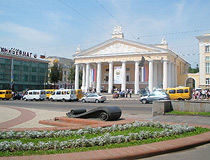
Bryansk Regional Drama Theater named after A.K. Tolstoy
Author: Aramis Rusketeer
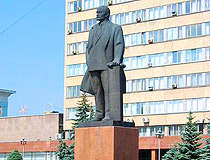
Lenin Monument in Bryansk
Author: Kudinov D.M.
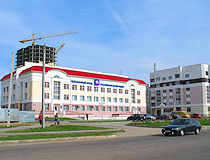
The office of the Pension Fund of Russia in Bryansk
Author: Yuriy Luchin
Bryansk - Features
Bryansk is located on the western edge of the Central Russian Upland, on both banks of the Desna River. This is one of the few Russian cities which age exceeds 1,000 years. Bryansk consists of four large districts located at some distance from each other and is surrounded by forests, which positively affects the air quality in the city. The City Day of Bryansk is celebrated on September 17.
The climate is temperate continental. Winters are characterized by unstable weather: from severe frosts to prolonged thaws, summers are wet and warm, but extreme heat is rare. The average temperature in January is minus 7.7 degrees Celsius, in July - plus 18.6 degrees Celsius. The best time to travel to Bryansk is from May to September.
Bryansk is a large industrial city. Metalworking is the main industry of the local industry. Chemical, electrical, electronic, woodworking, textile, and food industries are also relatively well developed. More than 1,200 enterprises of Bryansk produce diesel locomotives, freight cars, graders, pavers and other road equipment, agricultural machinery, construction materials, clothing, and other industrial products.
The city is a major railway junction through which railway lines run to Moscow, Kiev, Kharkov, Gomel, Smolensk, Orel, and Vyazma. The Bryansk Airport provides regular flights to Moscow, St. Petersburg, Sochi, Krasnodar. The public transport system of Bryansk includes buses, trolleybuses, trams, and minibuses.
A lot of people come to Bryansk purposefully to improve their health in the local sanatoriums. On the outskirts of Bryansk in the thick of forests there are health camps for children, sanatoriums and recreation centers for everyone.
This city has a number of noteworthy tourist sites: Orthodox churches, memorials in honor of the heroes of the Second World War, museums, and theaters. The Dvina flowing through Bryansk is a picturesque river, which right bank rises above the water surface and the left one is dotted with small sand spits. Most of the sights of Bryansk are located in its historical center on the right bank of the Desna.
Main Attractions of Bryansk
The Mound of Immortality - the main memorial to the fallen in the fight against Nazi Germany during the Second World War. At the top of the mound there is a huge five-pointed star. One of the symbols of Bryansk, it is located in the Park of Culture and Leisure “Solov’i” (“Nightingales”) opened in honor of the millennium of Bryansk. The height of the star made of concrete is 18 meters, the height of the artificial mound is 12 meters.
The mound consists of over 20 thousand tons of soil brought from mass graves from all over the Bryansk region, from other hero cities, as well as from the Bulgarian town of Shipka as a symbol of unity of the Slavic peoples, who suffered during the war. Two granite stairs lead to the top of the mound, where the observation deck is located. From here you can enjoy panoramic views of the Desna River.
Gagarin Boulevard - the only pedestrian street in Bryansk located in the historical center. The length of the street is about 1 km. Its southern part is a wide sloping stairs called “Potemkin Stairs” (by analogy with the famous Potemkin Stairs in Odessa, Ukraine) descending to Slavyanskaya Square on the bank of the Desna River. On the boulevard there is a monument to Yuri Gagarin - the first human in outer space. He visited Bryansk and walked along this street in 1966.
A number of houses on the boulevard were built in the 19th century: the House of Banks and Industry, the Wine Castle, the estate of Dr. Polyansky, and others. The clock installed on the boulevard shows time, the temperature regime, as well as the level of radiation background, since Bryansk Oblast is not so far from Chernobyl, Ukraine.
Alexey Tolstoy Park Museum. This park, founded in 1936, was named after the playwright Alexey Tolstoy, who was born in the Bryansk region. Due to its unique collection of wooden sculptures based on Russian fairy tales, this place is considered the favorite resting place for locals and visitors of the city. Entrance to the park is free and around the clock.
The Bryansk Museum of Local Lore - the main museum of Bryansk Oblast. The archaeological hall illustrates the life of ancient people in the Bryansk region in the Bronze and Iron Ages, the Mesolithic, and Paleolithic. You can also see a wide range of weapons: from Old Russian weapons of the 10th-13th centuries to more modern firearms, cold weapons of the 16th-19th centuries.
There is an exposition about the period of the Second World War, including the partisan movement, which was extremely active in the Bryansk forests. A rather large section is devoted to the flora and fauna of the region. Partizan Square, 6. Opening hours: 10:00-18:00. Day off: Monday.
Pokrovskaya Mountain. You can find two interesting monuments here. The first one is a sculptural group depicting the hero (“bogatyr”) of Peresvet, a participant in the Battle of Kulikovo and the guslar Boyan. The second one is a monument built in honor of the 1000th anniversary of Bryansk in the form of a stele crowned with a female figure with a sickle and hammer. From the top of the mountain you can see a beautiful panorama of Bryansk and the banks of the Desna River.
The Church of the Intercession of the Blessed Virgin Mary on Pokrovskaya Mountain. Its bright blue domes with golden crosses are visible from afar along with the stele in honor of the 1000th anniversary of Bryansk. This is the oldest church in Bryansk (1698). Architecturally, the building is a mixture of the traditions of Russian architecture of the 17th century with the techniques of the Naryshkin baroque.
Partizan Square. Its main attraction is the monument to the liberators of Bryansk erected in the 1960s and glorifying the feat of soldiers and partisans of the Bryansk region. The monument consists of a 22-meter obelisk of Victory and sculptural groups located on the sides depicting partisans and soldiers.
The Museum of the Tkachev Brothers. Alexey Tkachev and Sergey Tkachev, famous Russian artists, were born in the Bryansk province. In 1995, the museum in their honor was opened on the territory of a small mansion of the early 20th century. The collection consists of paintings, personal items, documents relating to the life and work of these artists. The museum also offers interesting thematic tours. Kuibysheva Street, 2. Opening hours: 10:00-18:00. Day off: Monday.
The Bryansk Regional Art Museum and Exhibition Center - a small art museum where you can see the works of Russian and Soviet painters of the 19th-20th centuries, icons of the 19th century, sculptures, and works of artisans. Emlyutina Street, 39.
Svensky Monastery - one of the oldest and most famous monasteries in Russia, founded according to some sources in 1288. Most of the buildings belong to the so-called Sloboda baroque, characteristic of the church construction of Ukraine in the 17th century. It is located in the village of Suponevo, a few kilometers south of the city limits.
Partizanskaya Polyana (Partisan Glade) - a memorial complex located about 12 km east of Bryansk in the very place where partisan units met during the Second World War to coordinate and plan further actions against the Germans. The gradually formed sculptural ensemble includes a 20-meter obelisk, marble steles, a museum, an exhibition of military equipment, the Memory Alley, and the Eternal Flame.


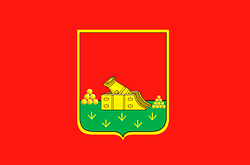
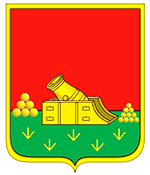
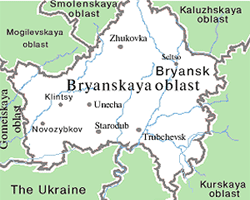



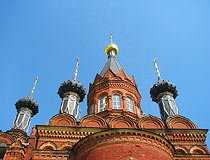
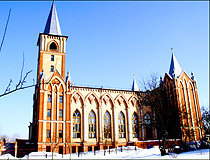
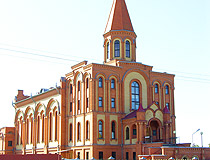
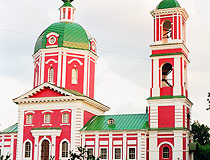
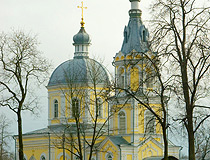
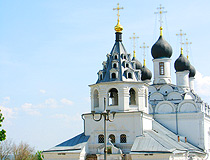
The comments of our visitors